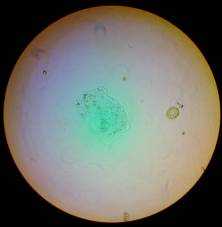 |
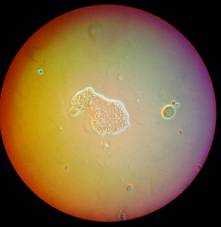 |
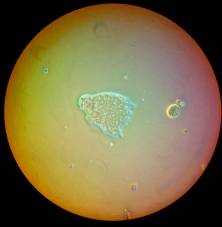 |
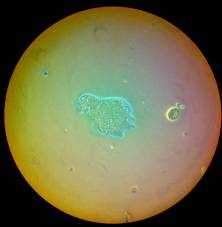 |
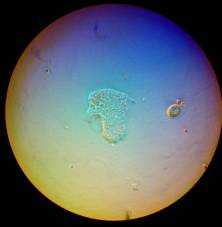 |
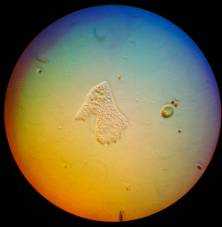 |
| Off Axis COL Update By Paul James. |
Introduction .......Having raised interesting 'episcopic' style imagery with good contrast and highlight relief using the x 20 objective as illustrated in the first article , I wanted to achieve similar results with the x 40 objective, but at that time I failed to do so. Serendipity once again has lent her hand and I have been able to repeat the procedure with the higher power objective during a session of experimentation of extreme settings with the Abbe and the field diaphragm.
Those who have taken to COL lighting techniques will no doubt have developed it to their own satisfaction by marrying substage annuli to suitable objectives etc.. The fundamental problem when trying to optimise COL is that there is no precedent to follow: no time honoured methodology to draw from, and precious little information apart from snippets buried in archives. The few earlier practitioners of COL referred to it as 'annular' illumination, which though strictly accurate could be confusing since other illumination techniques can be raised from annular stops such as darkfield, and of course phase contrast. The fundamental differences stem from the numerical aperture that each illumination annuli generate in the substage condenser's image of the illumination source. COL annuli are by default gauged to be within a zone of about 50-95% of a given objective's na, which can be checked visually at its back focal plane. The contrast inducing and tonal effects are raised in varying degrees throughout this range.
The 'O' in COL simply refers to the word oblique, which by encompassing it into the phrase 'Circular Oblique Lighting' I believe more accurately conveys the essence of what this lighting technique is actually about.
Working Offset COL with the Abbe .......My philosophy regarding the Abbe condenser is, if at all possible to utilise its chromatic flaws in certain situations to positive effect.
 |
 |
 |
 |
 |
 |
The images of whole fields above are shown to illustrate the general pattern of effects using a moderate to tightly closed lamphouse iris and offset COL annulus which should ideally be able to move all round the compass for better chance of finding optimum imagery. Conversely the condenser/annulus unit itself can be offset to reproduce similar effects. In all cases the elevation of the Abbe was an important consideration too. Often the juxtapositioning of the condenser/annulus's position can raise very satisfying colour textures to the periphery of a subject contrasting well with bordering colour tones in its close proximity. The outer field's appearance will often look excessively saturated with colour, but this can be ignored or suitably cropped in photo's. The field iris does play a pivotal role here with many settings in combination with the elevation of the Abbe and annulus.
Many of the factors of substage setup combine to make the raising of the favoured 'image' unique, and difficult to quantify accurately. I've tried to make sense of all this by adopting a regime or a routine when setting up, otherwise the subtle alterations required for success can be lost. I do not pretend to fully understand the process, but I've tried to remember the 'cause and effect' of parameters which are vital for success.
The very first is that all the essential ingredients for COL's successful functioning be in place. Coverslip thickness down to absolute minimum, as also the water film beneath it.....best results rendered when specimen clings to underside of coverslip. COL annuli should ideally be at the anterior focal plane of the substage condenser for best offsetting effects.......this often as not means the annulus residing inside the condenser's glassware.....easier for flip top types. Fixed annuli within a sealed condenser unit can be offset in unison to elicit the effects just as readily.
Also, yet perhaps just as essential is the suitability of the specimen. Here we find the most difficult problem since a favourite critter may simply not respond to this technique, and from my experience this is sometimes the case. Best then to concentrate on raising the effects initially on an easy target such as the slow moving amoeba, but not all respond favourably. The amoebae shown below can be found on rotting leaves: the flattish 'pancake' form which this technique easily throws into relief is the ideal starter specimen. More rotund examples of this protist are often impossible to portray like this because the relief effect seems to only cope with small variations of cellular height. Ciliates work well too but their energetic movements greatly compound the difficulties as always: Algae can be just as infuriating in a different way, but some nevertheless work well enough. Rotifers respond very well but their antics and Dof limitations test one's patience fully.
Adjustment of the field iris, Abbe elevation, as well as the offsetting of the annulus and or condenser for that matter is entirely subjective and will almost certainly differ from one observer's setup to another.
Reducing the annulus diameter for a given objective does increase depth of field of course to cope with fatter specimens, but the offset annulus effects diminish somewhat as a consequence, though the images raised, whilst more subtly rendered may appeal just as much to some individuals. This really is a technique that shines when all is well, but can all to easily raise useless imagery when conditions are not quite in order too:-
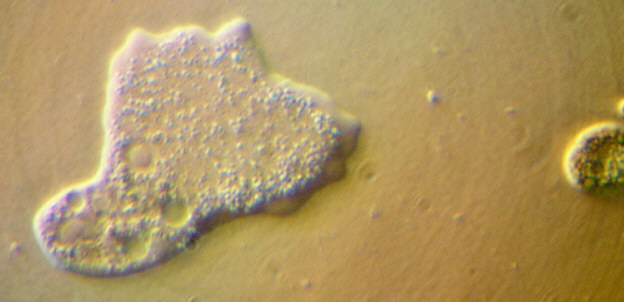 |
| Example of
poor image resulting from inappropriate field iris
closure and other settings etc. raising unwanted colour artefacts on the specimen in the process. |
IMAGE GALLERY
Following images straight out of camera pixel for pixel (Wild Fluotar x40 objective 0.75na)
|
|
| The curious mixture of DF peripheral highlighting and colour offset effects are induced naturally by the Abbe and are easily brought into effect. |
|
| Both algal cell and Amoeba depicted in semi DF and offset COL. |
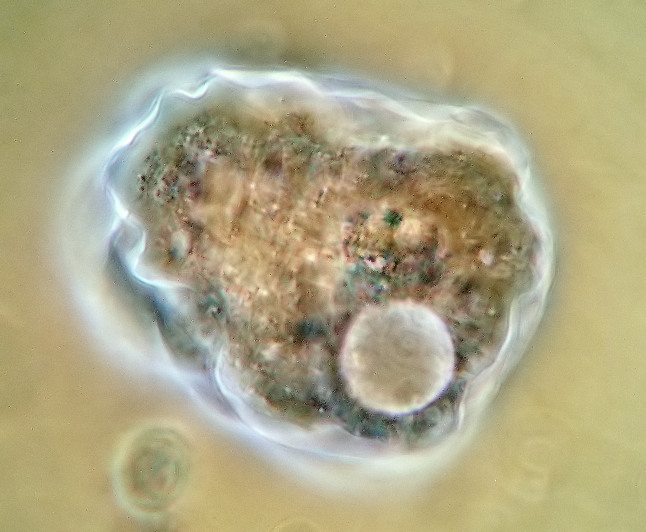 |
| Perhaps
not useful for science but another example of potential.
Note blurring of interior due to camera's slow ISO rating. |
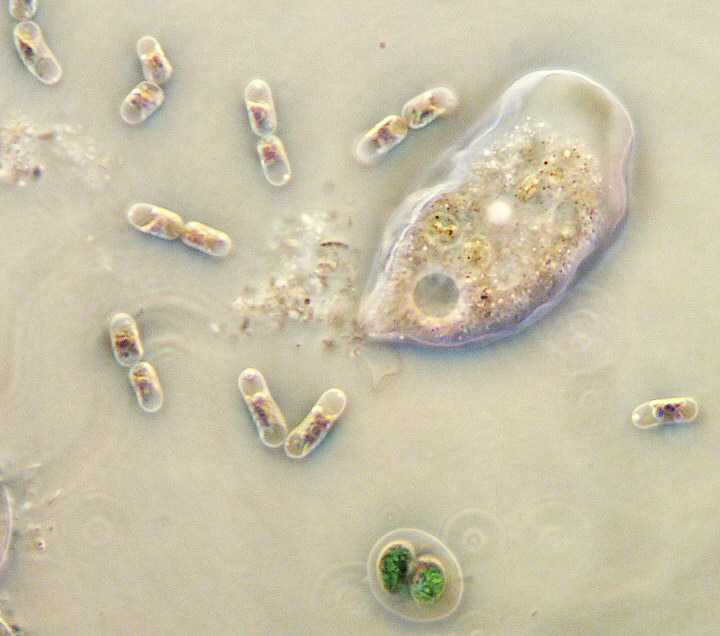 |
| Another example......... another effect. |
Concluding Thoughts
Had nature decreed the complete absence of chromatic and spherical aberrations in our image making pursuits through glass lenses, the 'contrivance' of an understage device replicating the Abbe condenser's flaws as we presently know it, would I believe, be welcomed as a curious but interesting novelty. Someone somewhere would inevitably use its peripheral colour artifacts for effect. Sadly we do not live in this utopian optical paradise, but we do have the Abbe, and it can be made to raise credible standard COL imagery, and also raise offset relief effects with a range of seamless colours to boot. The trick is to conjure its natural spectrum inducing properties into sensible use, but this is by no means an easy affair, especially as the particular combination of optical parts on your stand might vary considerably from mine and others, and specimens too for that matter.
Do not be surprised if after gaining success, you find repeating the process on another occasion stifled with frustration. Patience is the most important component of all, as this is most definitely not a technique for the observer in a hurry. There are several variables involved which translates into a rather large range of effects, many of which are of no use it must be admitted, but I've found settings which do respond very favourably for my purposes. Much depends too on your personal perspective of imagery, and is one reason amongst others why there is no point in me trying to quantify this technique more than I have done already.
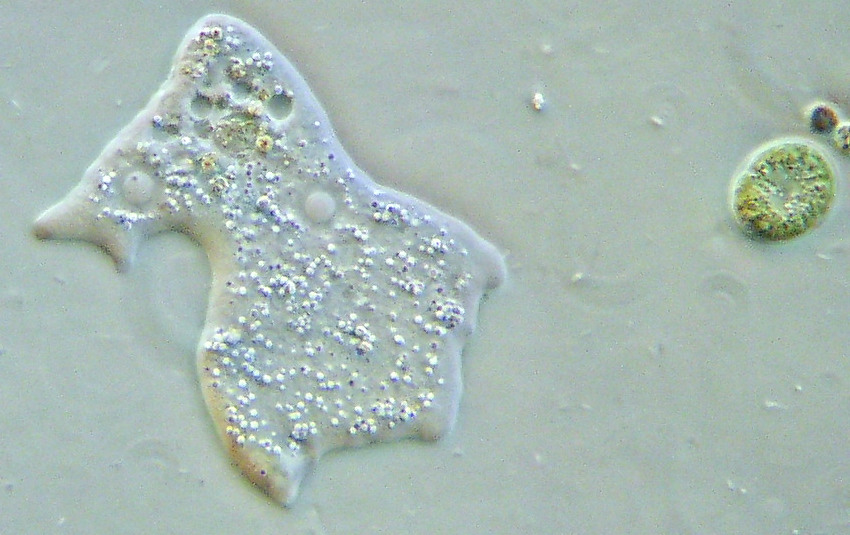 |
| Pixel for pixel
crop out of Minolta F300. Wild Fluotar x 40 objective.
Offset COL annulus, partial closure field iris. Abbe
0.9na fliptop Zeiss. Amplification x 750 onscreen. Tonal adjustments in 'Irfan View' software and 'Neat Image' noise reduction to simulate visual live appearance. |
COL's uncompromising sensitivity to mountant/water film thickness makes the whole process even trickier to put together, but when all the many ingredients are in place, the results can be really spectacular.
On a couple of occasions when raising a particular image for the first time ( such as shown above ), I subconsciously thought I was looking directly at the amoeba without optical aid, such was the clarity of its representation. This I hasten to add is an infrequent occurence, as I suspect there is more to all this than I am presently aware of. No matter, as a little bit of mystery is probably all to the good!
The author can be contacted via the Micscape Editor.
Microscopy UK Front Page
Micscape
Magazine
Article
Library
Please report any Web problems or offer general comments to the Micscape Editor.
Micscape is the on-line monthly
magazine of the Microscopy UK web
site at
Microscopy-UK